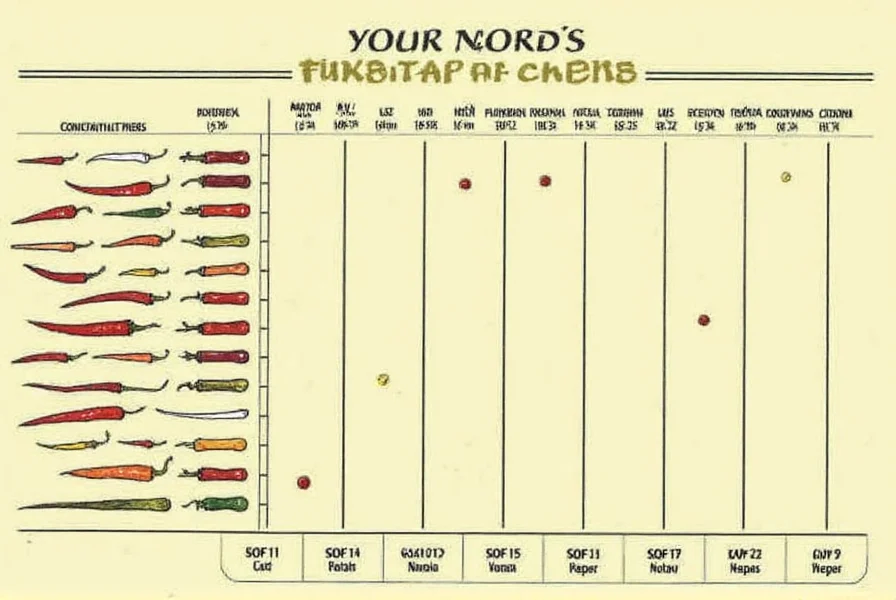| Pepper Name | Scoville Units | Heat Level | Common Uses |
|---|---|---|---|
| Bell Pepper | 0 | Mild | Salads, stir-fries, roasting |
| Sweet Banana Pepper | 0-500 | Mild | Pickling, sandwiches, garnishes |
| Poblano Pepper | 1,000-1,500 | Mild | Chiles rellenos, sauces |
| Jalapeño | 2,500-8,000 | Moderate | Salsas, tacos, stuffed peppers |
| Serrano Pepper | 10,000-25,000 | Moderate | Hot salsas, garnishes, ceviche |
| Cayenne Pepper | 30,000-50,000 | Hot | Spice blends, hot sauces, marinades |
| Thai Chili | 50,000-100,000 | Hot | Curries, stir-fries, Asian dishes |
| Habanero | 100,000-350,000 | Very Hot | Hot sauces, salsas, Caribbean cuisine |
| Ghost Pepper (Bhut Jolokia) | 855,000-1,041,427 | Extremely Hot | Extreme hot sauces, challenge foods |
| Carolina Reaper | 1,400,000-2,200,000 | Extremely Hot | World-record hot sauces, competitive eating |
Understanding the Scoville Scale
The Scoville Scale measures pepper heat through Scoville Heat Units (SHU), quantifying capsaicin concentration. Developed by Wilbur Scoville in 1912, modern testing uses high-performance liquid chromatography for precision. This scale helps cooks and spice enthusiasts select peppers based on desired heat intensity.
Practical Spice Usage Guide
For Beginners: Start Mild
Bell peppers (0 SHU) and sweet banana peppers (0-500 SHU) provide flavor without heat. Ideal for salads, roasting, or as mild garnishes. Use in dishes where you want color and crunch without spice.
Intermediate Heat: Jalapeños & Serranos
Jalapeños (2,500-8,000 SHU) and serranos (10,000-25,000 SHU) add balanced heat. Perfect for salsas, tacos, and stir-fries. Remove seeds and membranes for milder results.
Advanced Heat: Habaneros & Ghost Peppers
Habaneros (100,000-350,000 SHU) offer fruity heat for hot sauces. Ghost peppers (855,000+ SHU) require extreme caution—use gloves and small quantities. Ideal for specialty hot sauces or challenge foods.
Buying Guide for Peppers
1. Bell Peppers
Features: Sweet, crunchy, available in red, green, yellow, and orange varieties.
Best For: Beginners, health-conscious eaters, and colorful dishes.
2. Jalapeños
Features: Green or red, slightly smoky when roasted. Heat varies by growing conditions.
Best For: Tacos, salsas, and everyday cooking. Pickled jalapeños add tangy heat to sandwiches.
3. Habaneros
Features: Orange or red lantern-shaped peppers with floral, fruity notes.
Best For: Hot sauces, Caribbean dishes, and flavor-forward heat. Use sparingly—1/4 pepper often suffices for a pot of stew.
Frequently Asked Questions
What is the Scoville scale and how does it work?
The Scoville scale measures pepper heat in Scoville Heat Units (SHU) by quantifying capsaicin concentration. Modern testing uses high-performance liquid chromatography for accuracy, replacing the original human-taste method.
What's the mildest pepper on the spiciness chart?
Bell peppers have 0 SHU and contain no capsaicin. Other mild options include sweet banana peppers (0-500 SHU) and pimento peppers (100-500 SHU).
What's the hottest pepper in the world?
The Carolina Reaper holds the Guinness World Record at 1.4-2.2 million SHU. Unverified peppers like Pepper X claim higher heat, but only Carolina Reaper is officially recognized.
Why do some jalapeños feel hotter than others?
Heat varies due to growing conditions: soil composition, temperature stress, and plant maturity. A single plant may produce peppers ranging from 1,000 to 8,000 SHU.
How can I reduce heat in an overly spicy dish?
Add dairy (milk, yogurt) to bind capsaicin, acids (lemon juice), sugars, or starchy foods (rice, bread) to absorb heat. Diluting with more ingredients also helps.
Does cooking affect pepper heat?
Yes. Roasting mellows heat slightly while enhancing flavor. Cooking in sauces or stews releases capsaicin into the liquid, intensifying overall heat. Drying peppers concentrates capsaicin, increasing SHU.
How should I handle extremely hot peppers safely?
Wear gloves, avoid touching your face, and work in a ventilated area. Wash all surfaces and tools with soap and water after handling. Capsaicin vapors can irritate respiratory systems.
Do pepper seeds contain the most heat?
No. The highest capsaicin concentration is in the white pith (placenta) surrounding seeds. Removing seeds alone won't significantly reduce heat—remove the pith for milder results.
Can I build tolerance to spicy foods?
Yes. Regular consumption desensitizes pain receptors over time. However, tolerance diminishes if you stop eating spicy foods for extended periods.











 浙公网安备
33010002000092号
浙公网安备
33010002000092号 浙B2-20120091-4
浙B2-20120091-4